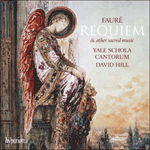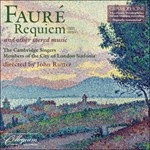It took some time for the music of Gabriel Fauré to achieve recognition outside his native France, even the now-familiar
Requiem making no real headway abroad until well into the 1940s. Born at Pamiers, in the département of Ariège, he trained at the École Niedermeyer in Paris where he attended the piano classes of Saint-Saëns and studied modal harmony and plainsong. In time he was destined to become director of the Paris Conservatoire, but his interest in church music waned and he eventually gave up his choir training and organ playing. Faure’s Op 47 consists of an
O salutaris for solo voice and the present
Maria, mater gratiae for two voices. Both works are provided with an organ accompaniment. The latter was completed in March 1888, shortly after the first version of the
Requiem had its premiere at the Church of the Madeleine, and was scored for tenor and baritone voices. An arrangement for soprano and mezzo followed later in the year.
from notes by Wadham Sutton © 1993
La musique de Gabriel Fauré mit du temps à se faire connaître hors de France; même son
Requiem, aujourd’hui partout célèbre, ne commença à être exécuté à l’étranger que dans les années 1940. Né à Pamiers, dans l’Ariège, Fauré entra à l’école Niedermeyer, à Paris, où il suivit les classes de piano de Saint-Saëns et étudia l’harmonie modale et le plain-chant. Il devait devenir par la suite directeur du conservatoire de Paris, mais son intérêt pour la musique d’église décrut, si bien qu’il finit par renoncer à ses occupations de choriste et d’organiste. L’opus 47 de Fauré comprend un
O salutaris pour voix soliste, et le présent
Maria, mater gratiae pour deux voix; l’un et l’autre sont accompagnés d’une partie d’orgue. Le
Maria, Mater gratiae pour ténor et baryton, fut terminé en mars 1888, peu de temps après la première du
Requiem à l’église de la Madeleine, et fut suivi la même année d’un arrangement pour soprano et mezzo.
extrait des notes rédigées par Wadham Sutton © 1993
Français: Jean-Paul Metzger
Es dauerte einige Zeit, bis die Musik von Gabriel Fauré auch außerhalb seines französischen Vaterlands anerkannt wurde. Sogar das heute bekannte
Requiem erreichte erst in den vierziger Jahren einen Durchbruch. Fauré, geboren in Pamiers im Bezirk von Ariège, studierte an der Niedermeyer-Schule in Paris wo er den Klavierstunden von Saint-Saëns beiwohnte und modale Harmonie und Gregorianischen Gesang studierte. Mit der Zeit schien er bestimmt, Direktor des Pariser Konservatoriums zu werden, doch sein Interesse an Kirchenmusik ließ nach und er gab seine Chorübungen und Orgelspiel schließlich auf. Faurés Op 47 besteht aus einem
O salutaris für Solostimme und dem hier vorliegenden, zweistimmigen
Maria, mater gratiae. Beide Arbeiten haben Orgelbegleitung. Letztere wurde im März 1888 vollendet, kurz nachdem die erste Version des
Requiems in der Madeleine-Kirche Premiere hatte, mit einer Partitur für Tenor- und Baritonstimmen. Ein Arrangement für Sopran und Mezzosopran folgte später im gleichen Jahr.
aus dem Begleittext von Wadham Sutton © 1993
Deutsch: Heidi Kerschl


 Fauré: Requiem & other sacred music
Fauré: Requiem & other sacred music Fauré: Requiem & other sacred music
Fauré: Requiem & other sacred music
